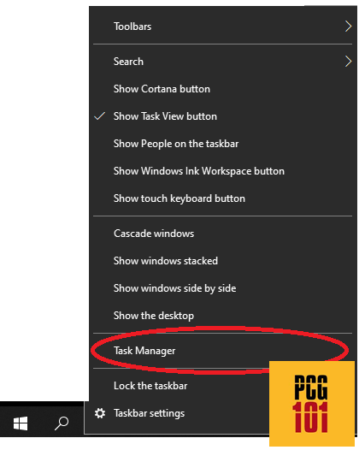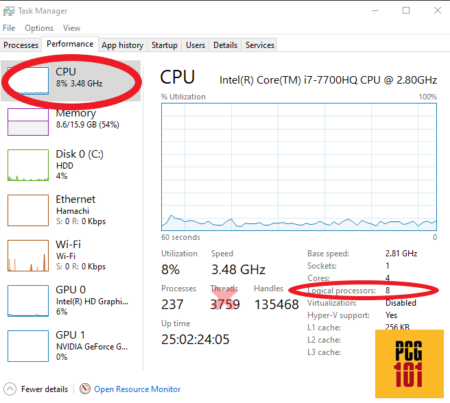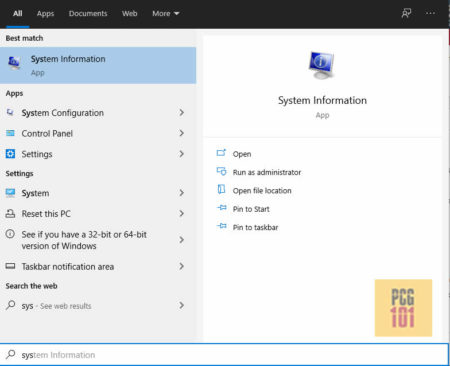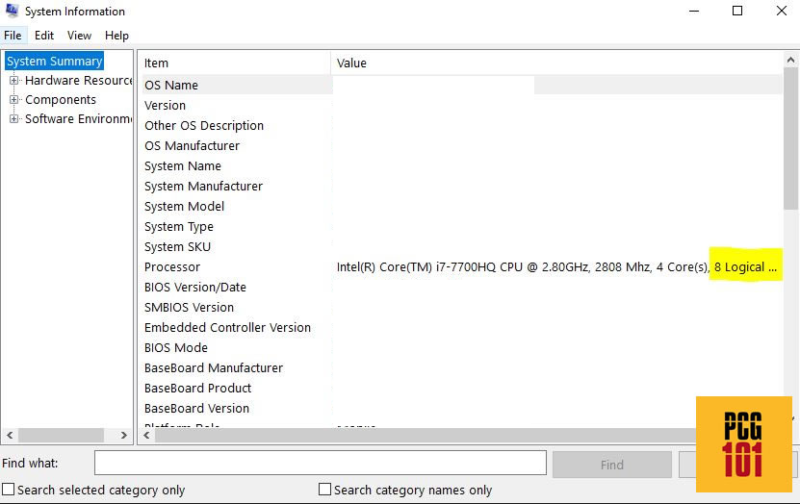You can check the number of threads on your CPU using built-in Windows services and tools like task manager and system information. You can also check through the manufacturer’s spec sheet and by using some third-party apps.
The amount of threads your CPU has depends upon its model, core count, generation, and whether it has enabled simultaneous multi-threading (SMT) like hyper-threading.
Newer-generation processors have more threads than the previous gen CPUs because they have more cores.
The higher the number of threads you have, the better the CPU performance since having more lines means your CPU has more workers (resources) at its disposal.
A higher thread count is advisable for multitasking, multi-threaded games, and professional tasks like video rendering.
In the text below, we will explore different ways to check how many CPU threads you have.
TABLE OF CONTENTS
How do I Check How Many CPU Threads I Have?
The following are some ways to check how many CPU threads you have. Most of these are as easy as pie.
- Use the Task Manager in Windows
- Use System Information in Windows
- Use Manufacturer’s Information
- Use a Third Party Software
I will detail each method below:
1. Check Using the Task Manager in Windows
Using the Task Manager is the easiest method to check how many CPU threads you have. In addition to threads, you can check out other information regarding your CPU, such as its clock speed, cache memory, model, etc.
Step 1: Open The Task Manager
There are many ways to open the task manager.
Method 1: Press CTRL+ALT+DELETE. On Windows 10, this will open a menu screen from which you can select “Task Manager.”
Method 2: Right-click on the Taskbar on Windows and Select Task Manager.

Step 2: Head Over to the Performance Tab
With the Task Manager open, head over to the performance tab

Step 3: Check the Amount of Logical Processors
Ensure the “CPU” tab is selected from the systems shown on the left-hand side.
The threads on the processor are also known as “Logical Processors.” Therefore, check out the number of logical processors the Task Manager shows.

Note, do not get confused by the field marked as “Threads” (which, in this case, is 3759). This shows the number of program threads or codes running at the moment. It has nothing to do with the number of lines on your CPU!
Also Read: Is a Dual Core Processor Good for Gaming?
2. Check Using the System Information Tool
There is another handy tool in Windows that you can use to find out a lot about your PC. It is called the “System Information” tool.
Step 1: Type System Information in the Search Bar
Type “System Information” in the search bar and select the app.

In the older Windows version, you can also go to “Run” and type “msinfo.32”.
Step 2: Look for the Processor Field
This tool will show you a lot of information in a single organized table.
What you want to look for is the “Processor” field.
In this field, look for the amount of “Logical Processors” it outlines. This is the number of threads you have in your CPU.

3. Check Using the Manufacturer’s Information
Chip manufacturers tend to have a listing of their CPU models and their specifications online.
This method can come in handy if your CPU isn’t yet installed in the motherboard or you want to get information regarding the CPU you have yet to buy.
However, you must know the processor’s make and model to make this method work.
A quick web search on Google for the make and model of your CPU can land you on the manufacturer’s website, where you can search for the exact CPU model and get its information.

Also Read: How to Check What CPU You Have?
4. Using Third Party Software
You can also use FREE third-party software such as CPU-Z and HWInfo to learn microscopic details regarding your PC Hardware, including the CPU.
You need to download and install these, but if you want to learn every minute detail about your system, these are some of the most comprehensive free tools in the market.
Most third-party software is dense with information and is generally used by experts.

Also Read:
What is a Thread in Simple Terms?
A thread is a series of codes you can think of as a conveyor belt that processes data. Since these aren’t actual cores, they are called “Logical Processors.”
Each core in a processor has at least a single thread. However, you can have two threads per core on CPUs with simultaneous multi-threading (SMT) enabled, which most CPUs do now.
So if a CPU has 2 Cores/4 Threads, 4 Cores/8 Threads, 8 Cores/16 Threads, and so on, then in this case, the CPU has multi-threading capability.
If a CPU has 2 Cores/2 Threads or 4 Cores/4 Threads, then in this case, the CPU does not have multi-threading enabled.
The amount of threads you have is generally the defining feature of how good a CPU is at multitasking.
When looking at the multi-core performance of a CPU, the number of threads can make a significant difference in the benchmarks results.
The difference in threads is profound when performing tasks such as rendering, encoding, simulation, or data science designed to use many simultaneous cores and threads.
Gaming can also indirectly benefit from a higher thread count, particularly if you have software and services, like streaming services, running parallelly in the background.
Also Read: What Does Processor Count Mean?
What Is Multi-Threading?
As mentioned earlier, multi-threading is when a CPU has more than one thread per core.
Many people also know this by the name of Hyper-Threading (Intel’s proprietary multi-threading method for their CPUs.)
Not all tasks, however, benefit from a very high thread count.
Some tasks, primarily games and professional tasks like designing in CAD or sculpting in Blender, are highly single-core/thread oriented.
Also Read: How to Check How Many PCIe Slots I Have?
Conclusion
Knowledge of the number of cores and threads a CPU has is vital for understanding its capabilities and price range.
It is common to ask how many CPU threads you have; fortunately, there are many ways to figure this out.
The best way to find out is to use built-in Windows services and tools such as Task Manager and System Information.
You can also use the manufacturer’s website, but you will need to know the exact model of your CPU for this. Whichever method you prefer will depend on the density of information required.
If you want every little detail about your CPU, third-party software like CPU-Z is recommended.
Also Read: How Many Cores Does an i3 Have?
FREQUENTLY ASKED QUESTIONS
1. How can I check the number of CPU threads on my Windows or Mac computer?
To check the number of CPU threads on your Windows computer, you can open the Task Manager by pressing Ctrl+Shift+Esc, and then navigate to the “Performance” tab. Under the CPU section, you’ll see the number of threads.
On a Mac computer, you can click the Apple menu, select “About This Mac,” and then click on the “System Report” button. In the left sidebar, click on “Hardware,” and then select “Processor” to see the number of threads.
2. Can I increase the number of CPU threads on my computer? If yes, how?
No, you can’t increase the number of CPU threads on your computer. The number of threads is determined by the physical hardware of your computer’s processor, and it cannot be changed without replacing the processor.
3. Is it possible to check the number of CPU threads on my computer through the BIOS?
Yes, it’s possible to check the number of CPU threads on your computer through the BIOS. You can enter the BIOS by pressing a specific key (e.g., F2, Del, or Esc) during startup, depending on your computer’s manufacturer.
In the BIOS, navigate to the “CPU” or “Processor” section to see the number of threads.
4. What are some tools I can use to monitor CPU usage and thread count on my computer?
There are several tools you can use to monitor CPU usage and thread count on your computer, such as Task Manager and Resource Monitor on Windows, and Activity Monitor on Mac.
Additionally, third-party tools such as CPU-Z, HWMonitor, and Core Temp can provide more detailed information about your CPU’s performance.
5. Can I disable CPU threads to improve my computer’s performance?
No, you cannot disable CPU threads to improve your computer’s performance. Disabling threads can actually degrade your computer’s performance because it reduces the number of tasks your CPU can handle simultaneously, causing a bottleneck in processing power.

Good